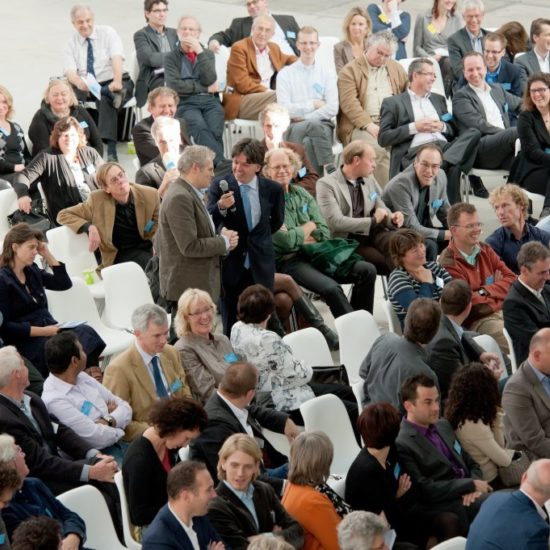Marianne Dijkshoorn is an expert in the field of event accessibility and an experiential expert : she has difficulty walking and uses a wheelchair for longer distances.
She is the author of the book ‘Maak je event toegankelijk voor iedereen’ (Make Your event accessible to everyone) and has advised, among others, the Eurovision Song Festival in Rotterdam on their accessibility.
During the BEA Festival, she spoke about inclusion and accessibility. She let attendees experience first hand how disadvantaged you still are if you are a wheelchair user, blind, deaf and so on.
For me as a wheelchair user, the feeling of belonging – truly belonging – starts with diversity. If I am not the only person with a disability or impairment, then I immediately feel more at home. The more diverse the public, the less excluded an individual minority will feel.
However, when you watch the videos of the nominated projects during the Best Event Awards, you still primarily see 'happy white people'. And even at the BEA event itself, this image remains.
But greater diversity alone does not necessarily mean that everyone really feels welcome. This raises the issue of inclusion, which in my case is all about accessibility.
In addition to many other sessions with a focus on the events industry, BEA attendees had the opportunity to take part in an ‘Inclusion Parcours’, where they went around the event location in a wheelchair or with a white cane (for the visually impaired). This let them experience the event from the perspective of someone with a disability, a temporary one in their case, and showed them how non-inclusive the events they organise generally are.
The wheelchair experience
Four wheelchairs were available for use in the event location. People were walking this way and that, crisscrossing paths, and would suddenly stop to talk with each other. When you’re sitting and the other people are standing, they don’t notice you right away. The wheelchair users said that it was quite a challenge to communicate that they wanted to pass: it feels uncomfortable and sometimes you really have to raise your voice to be heard, which can come across as unfriendly.
Another challenge was the cable duct challenge. In the middle of the space was one of those familiar black and yellow cable ducts (or maybe cable hump is a better term), which are there to prevent people from treading on the cables and damaging them or tripping over them.
Too few organisers realise that the solution to their problem (a way to keep the cables neat and secure) actually causes a problem for other people. Almost every wheelchair user had to make multiple attempts each time they wanted to pass over the cable duct, because the ramp of the cable duct is too angular. At the entrance to Hall 1, there were even two cable ducts positioned one after the other. This was an insurmountable challenge, and if you’re rolling into the hall after everyone has already sat down then you draw the attention of everyone present. Not very pleasant if you're in that wheelchair.
The solution may be a bit more work, but it’s certainly not impossible: conceal the cables along the top. Or use cable ducts that are designed for a wheelchair to pass (these actually are available to rent).
The networking challenge
And then there was coffee. The Italian espresso bar was easy to find and easily accessible. But once you’ve picked up your cup of espresso, you want to make room for the next person in the queue. The experience soon taught the temporary wheelchair users that rolling with drinks in your hand is virtually impossible. You had to pick up your drink at the bar, the staff did not bring it to you. So, the only option was to drink your coffee in front of the bar and hope that you weren’t in other people’s way.
The height difference already makes it difficult to network. Someone stated, “It is really quite a challenge to network when you are sitting down and everyone else is standing.” A somewhat more equal combination of high tables and sitting areas helps enormously.
The difference in height could also be felt during a number of industry-related sessions. A number of these were designed for spontaneous walk-ins, where everyone engaged in a standing conversation with each other. Good luck inserting yourself into one of these conversations in your wheelchair. And try having an equal part in those conversations when all you can see are people's backsides and don’t even know who’s speaking.
And at some point the espresso has to come out again, so it's off to the toilets. The venue has a wheelchair-friendly toilet, so that gives you some hope. But first you have to get there – once you reach the toilets, you find yourself facing a very steep ramp. Most of the wheelchair users gave it a try, but only a single person made it to the top without help. Most of them asked other attendees for a push. Everyone was pretty tired by the end of this challenge.
Musical chairs
Someone in a wheelchair, still rolling around in search of a place, asks where you can sit in the conference hall if all the chairs are chained together for safety. At most events, no consideration is given to wheelchair users, so they end up sitting in the back or in an aisle (where they are often blocking the way). These are not the nicest places to participate in the event, because you want to be part of the audience.
A simple option would be to place a wheelchair mat in an area where chairs have been removed. Chairs are brought out for people who can walk, so why not make a place for wheelchair users as well?



